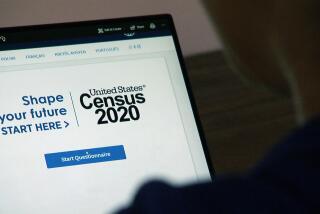Census Counts on Paid Campaign to Reach Out to All Americans
- Share via
Uncle Sam is facing up to one of the toughest marketing challenges of the millennium: convincing an increasingly privacy-conscious public to fill out 2000 census forms.
The Founding Fathers mandated the census in the Constitution, but a growing number of Americans no longer view the national head count as a patriotic obligation. As few as 55% may return the 98 million forms landing in mailboxes nationwide this week, down from 65% in 1990 and 78% in 1970. Every percentage point drop in the response rate pushes up the cost of completing the census by $25 million.
Determined to persuade the public to stand up and be counted, the Commerce Department in February launched its first paid census advertising campaign. The $167-million campaign, crafted by New York-based Young & Rubicam and several agencies that specialize in minority-language advertising, is flooding airwaves, print publications and billboards with ads in more than a dozen languages.
Government officials and advertising agency executives are confident that the campaign will sway Americans, but even observers who support the census acknowledge that it won’t be an easy sell.
A startling number of Americans don’t seem to care that census data shapes congressional districts and determines how $185 billion in tax dollars is distributed each year. Others undoubtedly will treat the decennial data request as another intrusion into their private lives.
“Whether it’s Beverly Hills worried about the [Internal Revenue Service] or East L.A. worried about the [Immigration and Naturalization Service], people are more reluctant to share information,” said Beatriz Lopez-Flores, an executive with the Los Angeles-based Mexican American Legal Defense and Educational Fund, or MALDEF, which has found corporate sponsors to fund additional advertisements urging participation by minority groups that were notably underrepresented in the 1990 census.
The easiest targets for the Census Bureau’s advertising campaign are older Americans--typically, better-educated whites--who need little more than a gentle reminder to drop completed forms in the mailbox.
The campaign’s real targets are younger Americans of all ethnic backgrounds who, for one reason or another, don’t know that the census is important. The campaign also aims at members of ethnic populations with a strong mistrust of government or who have a limited understanding of the critical role the national census plays.
Ad executives know that they must break through barriers with minority groups that “have a long history of mistrusting the government,” said Terry Dukes, a Young & Rubicam executive vice president. “There’s a real sense of not believing that, by filling out this form, I’ll get anything from the government.”
The spots also speak to people in the country without documentation, as well as recent legal immigrants who come from countries where citizens generally don’t share private information with the government.
“In the case of Mexican Americans, particularly lower-income, less-educated Mexican Americans, keeping a low profile has long been the survival strategy,” said Norma Orci, whose Los Angeles-based advertising agency, La Agencia de Orci & Associates, created ads for MALDEF that address immigrants’ concerns. “We’ve tried to emphasize the confidentiality of the information, which we know to be a culturally significant issue.”
Marketers say it’s one thing to lead hungry Americans to dinner and another to convince them to do the right thing. The campaign won’t, for example, reach many homeless people. Marketers also acknowledge that a one-shot campaign won’t change the way a nation thinks.
“It’s an enormous task, one that requires a mass education about what uses the census data have,” said Ilene Jacobs, director of litigation for California Rural Legal Assistance, a Marysville, Calif.-based group that believes 40% of migrant workers weren’t counted in 1990. “It’s hard to tell people in 30 seconds about all the meaning that the census will have for generations to come.”
The advertising campaign enjoys strong support from parties that don’t always see eye to eye. MALDEF and the NAACP are urging consumers to stand up and be counted, as are state and local governments. American Honda Motor Co., Chevron Corp. and other big companies have funded commercials and public service spots prepared by MALDEF and a Los Angeles-based coalition of Asian American community groups.
There’s more than good citizenship at work.
The Census Bureau spends $2 per form when the forms are returned promptly by mail. The average cost rises to $12 when census workers must make personal calls--and can skyrocket to $36 when workers have to track hard-to-reach respondents.
Local elected officials know that accurate counts can bolster federal financial support for bridges, highways, hospitals and schools. Civil rights groups are marching arm in arm with Uncle Sam because past census counts have severely undercounted minority groups.
“I don’t think the Census Bureau ad campaign will reach most of the migrant seasonal farm worker population,” Jacobs said. “So we’re working with Spanish-language radio stations and doing additional outreach to reach them.”
Business views an accurate census as a demographic pot of gold. Marketers have reams of data about the slow-growing white population, but know relatively little about the fast-growing Latino and Asian American populations. As the white population ages, marketers are gearing up to target faster-growing minority groups.
“Immigration is fueling the wave, which means more research is constantly needed,” said Bill Imada, co-founder of Imada Wong Communications Agency, which produced census ads for the Los Angeles-based Asian Pacific Islander Census 2000 Network, which is urging Asian Americans to return census forms. “The census provides the accurate information marketers need.”
The $167-million budget sounds impressive, but it’s a small sum in the world of corporate advertising. Wendy’s International Inc., for example spent that much during the first nine months of 1999 alone, and burger behemoth McDonald’s Corp. spent $463 million.
“There’s never enough money,” acknowledged Daisy Esposito, president of New York-based Bravo Group, which produced Spanish-language ads for the national campaign. “But despite that, I think everyone involved agrees that this strategically focused message will move the dial. This is the first, real concerted effort to sell the census.”
Because of funding limitations, ads are designed to speak to broad ethnic groups. Spanish-language ads must speak to Miami’s heavily Cuban American community as well as Southern California’s large Mexican American population. Similarly, advertising that targets Native Americans is designed to work in Florida as well as in Alaska.
The national ad campaign orchestrated by Young & Rubicam uses shots of Americans at work and play. Spots targeting Native Americans show colorfully dressed tribal members along with the exhortation to be counted “not only for ourselves, but for all our Indian people.”
Spanish-language ads incorporate a sense of community by portraying Latinos as factory workers, doctors, teachers and fishermen. “The ads speak to Hispanic pride,” Esposito said. “Hispanics generally don’t think of themselves as individuals but as a community. The ads stress the individual’s need to fill out the form because we as a community need you to do it.”
The national advertising campaign includes spots titled “Without Fear,” in which actor and activist Edward James Olmos urges Latinos to be counted. MALDEF’s spots feature Spanish-language talk-show host Cristina Saralegui and salsa artist Celia Cruz, who emphasize the private nature of census responses.
Orci, whose agency helped craft advertising associated with a 1987 immigration amnesty campaign that drew millions of applicants, believes that Madison Avenue will be able to sell minorities and the general population on the census by offering convincing arguments about the benefits.
“Look at the amnesty campaign, which had to be the most counterintuitive thing--telling people in the country illegally to come out of the shadows and report to INS offices,” Orci said. “But it worked.”
(BEGIN TEXT OF INFOBOX / INFOGRAPHIC)
Speaking Their Language
In addition to ads in English, the Census Bureau’s $167-million advertising budget includes ads in Hindi, Chinese, Japanese, Korean, Vietnamese, Laotian, Cambodian, Thai, Tagalog, Hmong, Arabic, Russian and Polish.
*English speakers of all ethnic backgrounds over age 18
** Puerto Rico, Guam, American Samoa, U.S. Virgin Islands and the Northern Mariana Islands
Sources: Commerce Department, Census Bureau
More to Read
Get the L.A. Times Politics newsletter
Deeply reported insights into legislation, politics and policy from Sacramento, Washington and beyond. In your inbox twice per week.
You may occasionally receive promotional content from the Los Angeles Times.










